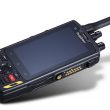Secure shipping
Some military cargoes en route from the United States to Germany will soon start “phoning home” to provide assurance that they’re secure and on the move.
The U.S. Department of Defense (DOD) and Department of Transportation (DOT) have launched a project to see if two systems, both employing wireless data communications, can work together to guarantee the security of international shipments.
The Cargo*Mate Chassis DataGate, from PAR Technology Corp. of New Hartford, New York, uses onboard sensors, the global positioning system (GPS) and a cellular network to capture and transmit real-time data on the status and location of a cargo chassis.
The EchoPoint SmartSeal Tag, from Savi Technology of Sunnyvale, California, uses radio frequency identification (RFID) technology to transmit data about intermodal containers, including an alert if anyone tampers with a container’s lock.
During the “European Container Security Test and Equipment Tracking Demonstration,” funded by the Federal Highway Administration (FHWA), the two companies will test the interoperability of these systems. They will use them to monitor cargo traveling between distribution centers run by the U.S. Defense Logistics Agency (DLA) and seaports in the United States and Europe.
Savi is one of several companies that manufactures “e-seals” — RFID tags that attach to the bolt locks on containers. If someone breaches a lock, that action breaks a field around its tag, and the tag records this violation. The next time the container passes an RFID reader, installed at a seaport, rail terminal, warehouse or other key location, the tag transmits an alarm.
PAR designed its Cargo*Mate to track not containers, but the chassis used to haul them to and from seaports and rail yards. It incorporates a GPS location unit and sensors that detect when a container is placed on or taken off the chassis. Cargo*Mate periodically transmits data about the chassis to PAR’s Operations Center. PAR then provides this information to authorized users through a Web interface or a link to a logistics management system.
Between checkpoints
Working together, the two systems should allow the DLA to monitor its containers at all times, wherever they are.
“Our system will let you know where you shipment is, what the status of it is, as it’s leaving a seaport and goes on a vessel,” said Mark Nelson, director of corporate communications at Savi.
But when there’s no reader nearby, the e-seal alone can’t transmit information.
“By marrying it with cellular systems linked with satellite, you’ll be able to know the status of your shipment while it’s on the ocean, or if it’s on the land between checkpoints, on the open road,” he said.
In the upcoming test, the integrated PAR and Savi systems won’t actually monitor goods at sea. Rather, they’ll track containers moving from the DLA’s depot in New Cumberland, Pennsylvania, to the Port of Norfolk, Virginia.
After a trip across the Atlantic, the PAR and Savi devices will again monitor the containers from the Port of Rotterdam to a DLA facility in Germersheim, Germany.
PAR and Savi will attach one of Savi’s portable RFID readers to the Cargo*Mate unit via a serial connection. While the container is in transit, that reader will interrogate the e-seal, and Cargo*Mate will transmit the resulting data.
With this system in place, “any breach between choke points could be detected and some kind of alarm could be sent to whatever device was needed to identify that as a compromise to the integrity of the seal,” said Greg Talomie, vice president and general manager at PAR’s Logistics Management Systems division.
While the seal remains intact, the system will report that fact as well, said Steve Farrell, director of product management for hardware at Savi.
In the United States, PAR transmits data on the Aeris.net Microburst network. Based in San Jose, California, Aeris.net provides nationwide coverage through agreements with multiple carriers, transmitting data over unused portions of the cellular channels
PAR chose an analog cellular network, at least for now, “for cost reasons and also ubiquitous coverage reasons,” Talomie explained.
For the overseas half of the demonstration, PAR needs to forge an agreement with a cellular carrier in Europe, Talomie said.
It also needs to modify its equipment to make it compatible with Europe’s Global Systems for Mobile Communications (GSM) standard.
Chassis visibility
PAR has been working on Cargo*Mate, with support from the FHWA’s intelligent transportation systems (ITS) program, since 1998. It first developed the system to help ocean carriers, railroads and trucking companies track their intermodal chassis, which often go astray as they move among transportation terminals and customer sites.
“They don’t have good visibility of these once they’re outside their controlled domain,” Talomie observed.
Onboard systems that trucking companies use to monitor their fleets, such as Qualcomm’s satellite-based OmniTracs, are too expensive to use on chassis, said Talomie.
Also, intermodal carriers need a device that stands up to rough handling. Chassis “typically get stacked upside down and moved around five high,” he explained.
BC Transportation, a Newark, New Jersey-based trucking firm that hauls containers to and from seaports, has installed Cargo*Mate on about 50 of its intermodal chassis. The company uses PAR’s system to track chassis moving among ports and customer locations in Newark, Baltimore, Norfolk, Cleveland, Columbus and Buffalo.
The system “is helping us not only know where exactly they are, but to manage them, so we can move them more cost-effectively to where customers require them,” said Robert Leef, president at BC Transportation.
The system also notifies Leef if a chassis sits in one place for too long, so he can make sure the unit hasn’t been misplaced, he said.
New security focus
While PAR first focused on commercial applications, as the nation turned more of its attention to homeland security, the company adjusted its charter. As part of a government-industry consortium developing technologies for intermodal transportation, PAR started pursuing ways to safeguard goods in containers.
Currently, PAR is involved in two projects that combine Cargo*Mate and e-seals. In one, it’s testing its units with RFID-based devices from E.J. Brooks of Livingston, New Jersey; some of those integrated systems are installed on BC Transportation’s fleet.
The second project is the demonstration with Savi.
The DOD has been using a logistics management system from Savi, based on its RFID tags and readers, since the late 1990s. The technology allows the DOD to track a container’s location and contents. The active tags, which transmit at 433.92 MHz, are the same ones Savi uses in its e-seals, Farrell said. Savi and the DOD have installed readers at key logistics “choke points” around the world.
Savi has installed its e-seals on more than 200 shipping containers as part of a transportation industry initiative called Smart and Secure Tradelanes.
“The key drivers are the world’s three largest seaport operators,” Hong-Kong-based, Hutchison Port Holdings, PSA Corp. in Singapore and P&O Ports in London, Nelson said. To help safeguard containers loaded with commercial cargoes, these companies have financed the installation of RFID readers at a dozen major seaports around the world, he said.
Susan Slye, communications liaison at the FHWA’s ITS Joint Program office, said her office couldn’t comment on the PAR/Savi demonstration until after the system gets up and running.
That should occur sometime this spring, according to Talomie. PAR and Savi were completing their integration work in January and hoped to start putting 50 units on containers and chassis moving out of New Cumberland in February.
“Phase two would be picking up visibility as they move, once the containers are landed in Rotterdam, and tracking them into Germany,” probably starting in April or May, he said.












